Sailing trip: 14 days from Rostock to Helsinki | May / June 2007 | Yacht: Bavaria 46 | Provider: Segelreisen Hering
Sunday, 27th May
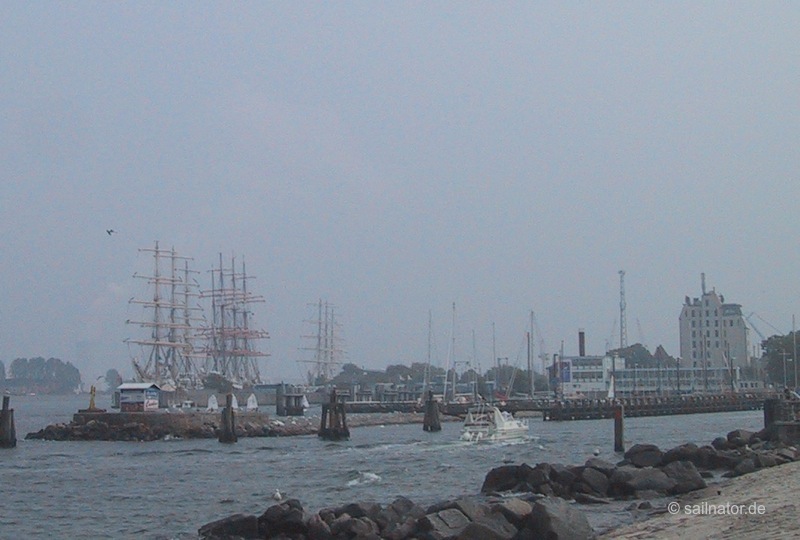
Windjammer in Warnemünde
We untie the lines early in the morning and leave the windjammers behind in Warnemünde that assembled there for a parade. We have set ourselves an ambitious target: We want to cross the Baltic Sea from Rostock in the north of Germany to Helsinki in Finland via Gotland and Riga in two weeks. The sky is cast over, but fortunately it does not rain. The first destination on this trip shall be Rønne on Bornholm. Without calling a port in between. Therefore we lack time. There is no wind at all and that means we have to turn on the engine. The beautiful coast of Mecklenburg-Vorpommern passes by in haze. The days are longer now at the end of May but still cool. We only cook some sausages in the early evening with potato salad. At this point I do not anticipate anything yet… but more about that later.
We have Cape Arkona on the Island of Rügen abeam when wind does finally come up – unfortunately directly from the direction of Bornholm. Waves slowly build up against which we have to drive. The bow always gets up and down between two waves. Memories of my trip on the strait of Bonifacio come back to me and I fear the worst. I try to stay up as long as possible because I do not want to go to my bunk with a full stomach. The fatty potato salad does not want to wander on and then it takes a wrong turn. Fortunately I do not get as lifeless as between Sardinia and Corsica, but enough to be unavailable for tonight’s watch . The skipper sends me to the bunk. I wedge a welly behind the door of my cabin so that it cannot fall over. I put a plastic bag inside and with this trick my bunks stays clean. To top it off all I lie in the front cabin and I have the feeling as if I fly a foot high above the mattress with every wave. But finally I do fall asleep.
Monday, 28th May
At about 05:00 a.m. we reach Rønne on the island of Bornholm. The first yachts are already leaving the port. Maybe they came in late at night yesterday when the harbourmaster was already gone and now they save on paying the harbour dues. At 07:00 a.m. I have a look out from the companion ladder. On the street above the harbour three human beings appear in white bathrobes and pink bathing caps. Their feet are hidden behind a low wall and so it seems as if they are hovering through the early-morning haze. At the beach the three graces (all about seventy years old) step into the sea. They swim around for one or two laps and then disappear as bizarrely as they arrived. Now fog comes up. Warm air streams over the cold Baltic Sea.
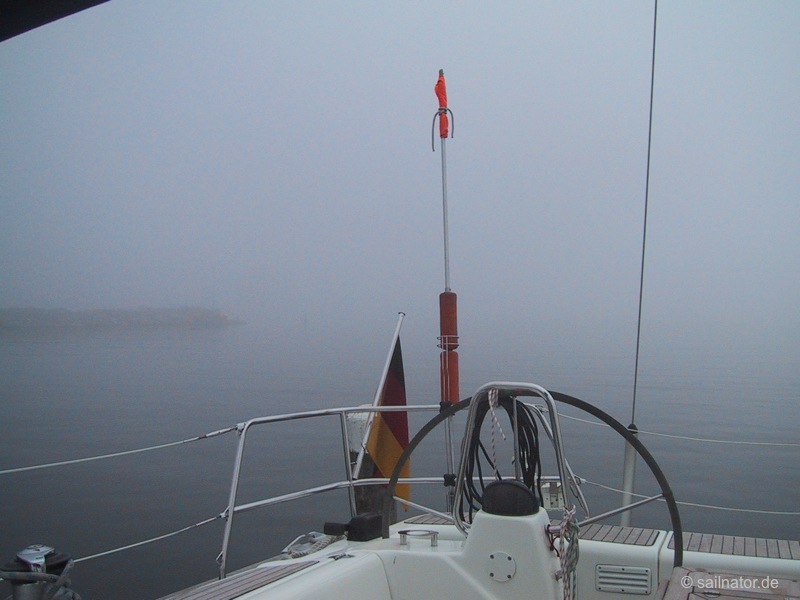
Fog in Rønne
Slowly life starts on our boat. I quickly dispose of my plastic bag on land and then I notice my enormous hunger and need breakfast. After washing the dishes the skipper commands shore leave. Unfortunately it is Whit Monday and Rønne is as good as closed today. I would love to explore the island now but we have to sail on. The next crew is waiting for the boat in Helsinki. And Helsinki is still far away.
Back at the marina the fog has disappeared and when we reach the harbour’s exit even the sun comes out. The skipper decides to go south around Bornholm. We sail very comfortably and everybody is relaxed. On the radio we hear more and more messages of yachts in trouble. We cannot understand that and make our jokes.
The horizon turns strangely milky and the wind decreases. Then suddenly the fog swallows us. A moment ago we sat on deck in swimming trunks and now we have to take on warm foul weather gear. Just in time, because suddenly it starts. The wind increases and we really have to fight now. The second reef follows immediately to the first. But we are making no progress. After a few hours of fighting the skipper has no choice but to change today’s destination. Originally the trip should have gone up between the island of Öland and the Swedish coast and then over to Gotland. We could try to get to the small island of Christiansø and wait for better weather there. But with these northerly winds this harbour cannot be recommended. And to anchor leeward the island is too dangerous in these conditions. In these circumstances and with this speed we will never get to Helsinki in time. So we decide to sail directly to Lithuania and from there into the bay of Riga.
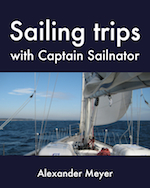 My sailing trips have also been published as ebook and paperback. For more information click here!
My sailing trips have also been published as ebook and paperback. For more information click here!
You can download the Ebook for example at:
iTunes UK & iTunes US | iBooks for iPad and Mac
Amazon.com & Amazon.co.uk | Kindle-Edition
Google Play | for Android
The paperback is available at: Amazon.com | Amazon.co.uk | Createspace
We sail on this course for about two hours as one of the crewmembers notices that the jib sail has torn. Fortunately so far only at the end of the seam. We furl the genoa but just with the mainsail we will not make it to Lithuania. So we tack and sail back to Bornholm. We reach Neksø late that evening. It was a long course through water but a short distance over ground that we sailed today. Our yacht is too long for the few empty boxes and so we go alongside the quay for the fishing vessels. We remove the jib and while we are cooking the skipper looks for a sailmaker. And there is one indeed. The harbourmaster calls him and makes an appointment for the next morning at 07.00 a.m.
Tuesday, 29th May
At 07.30 a.m. the skipper is back punctually to breakfast with the repaired jib. Big waves beat against the harbour wall, but we have to go out there. The tank is empty because we used the engine so much the last days and so we have to go to the fuel pump first. Out on the sea it is really uncomfortable. The sea is grey and turbulent but we have to hoist the sails. Anytime fog comes up again. A yacht reports problems with the jib on the radio. All 5 minutes they broadcast their position until a Russian carrier gives the displeased advice to keep channel 16 free for distress alerts. Meanwhile it is nearly impossible to see anything. I am supposed to be the lookout at the radar. Until this point of time I only heard the word radar but nothing more. I once saw in a movie that there is a white line turning on a black screen. The skipper realises that I am not the right man for this job. So I can stay on deck and escape getting seasick this way.
Now the navigator reports obstacles again and again, that he sees on the radar. We try to avoid them by tacking. But we see nothing. The fog is really too thick. Constantly new targets appear on the screen that we cannot immediately explain to ourselves. Only when we pass a buoy very close we understand: On the top of the buoy a radar reflector is fixed, making it easier for the fisherman to retrieve his nets.
It gets dark and the wind decreases. We secure the sails and start the engine. The fog gets thicker and thicker. It is hard to see the bow now. All two minutes we make a sound signal. By habit I make one long sound and two short sounds although we are a steaming vessel now and get the evil eye of the skipper. Later I want to be introduced in the secrets of the radar as suddenly a big target whizzes by very fast. But we cannot hear anything and most definitely cannot see anything. Our attempted explanations are waterspout or high-speed ferry. We are not sure, but it is definitely very scary.
Wednesday, 30th May
We drive on the whole night by engine again. Against the wind or totally without it. I do not have any memory of it. Equally not for the following day. Perhaps I was seasick again. But suddenly it happens: The helmsman stands at the wheel of the dual steering on port side and the next person wants to take over on starboard. He gives the sign that he is ready now. He turns the wheel to compensate the windward tendency of the bow that begins immediately when his predecessor releases on port side. But nothing happens. The bow continues to turn into the wind. The helmsman turns the wheel back and forth hectically, but it is pointless: we have a damaged rudder. Quick-witted the skipper grabs the port side wheel. Pooh! To the relief of the whole crew it has still contact to the rudder and the boat can be stabilised. But how long will that last? Immediately the skipper and one of the crew climb into the storage locker. It is terrible narrow down there. Darkness and swell make working very hard. It turns out that one piece of the chain is broken out. It could not stand the burden of the last days anymore. I am invited to have a look at the damage but I categorically refuse. In the narrow with the head facing down seasickness is inevitable. Certainly we do not have the replacement part on board. We bypass it by a piece of wire and the starboard wheel is turning again. Now we can hope that it will keep on working like this till we reach the next harbour.
In the evening we reach the small fishing port of Grönhögen on the western side of the southern tip of Öland. We do not see anything of the place. We are too tired to take a shower and the next morning there is no time for it.
Thursday, 31st May
We drive up the strait between Öland and Sweden by engine till we reach Kalmar. Fortunately the sea calms and the rudder does not have to work on its limit anymore. At the berth for the guests we have to turn the stern towards the pier and pick up a mooring ball along the way. Because we sailed for so many nights and did not practice berthing very often, the manoeuvre does not work immediately. After the first try the buoy is too close to the pier for our long vessel and we have to do it again.
The skipper now looks for the replacement parts for all the things that broke underway. Some of the crew go shopping and the others refill the water tank. And all are looking forward for a shower. In the late morning we start a tour to the town to see its sights.
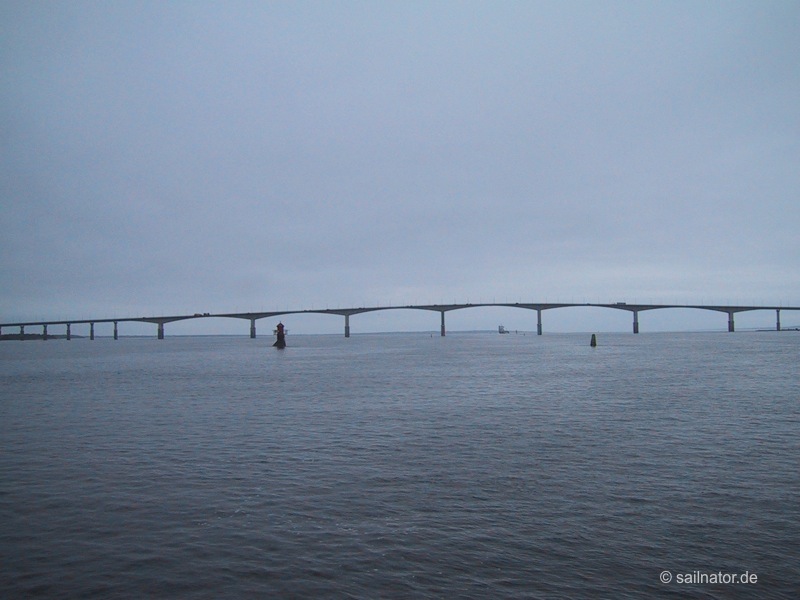
Ölandsbron
In the early afternoon we are out on the water again and drive down through the bridge that connects Sweden and Öland by engine. We enter the Kalmar strait now. The journey continues very slowly and gets boring. The coast of Öland passes by completely grey. It is hazy, the engine rattles and the cool humidity crawls under the foul weather gear.
Friday, 1st June
At some point yesterday evening we rounded the north tip of Öland. Now fog comes up again, but we can finally hoist the sails and head towards Gotland. We now have to cross one of the busiest straits of the Baltic Sea. Every ship going to Stockholm from the south or who coming from there have to pass through. Carriers and Ferries and especially tricky: the fast ferries that rustle through the water with their double hulls. This is as well as the ferries following us to Gotland and those that come from there. In the fog it is only the yawing rig and the small radar reflector that makes us visible on the radar screen of the big vessels. It is scary, but also very fascinating!
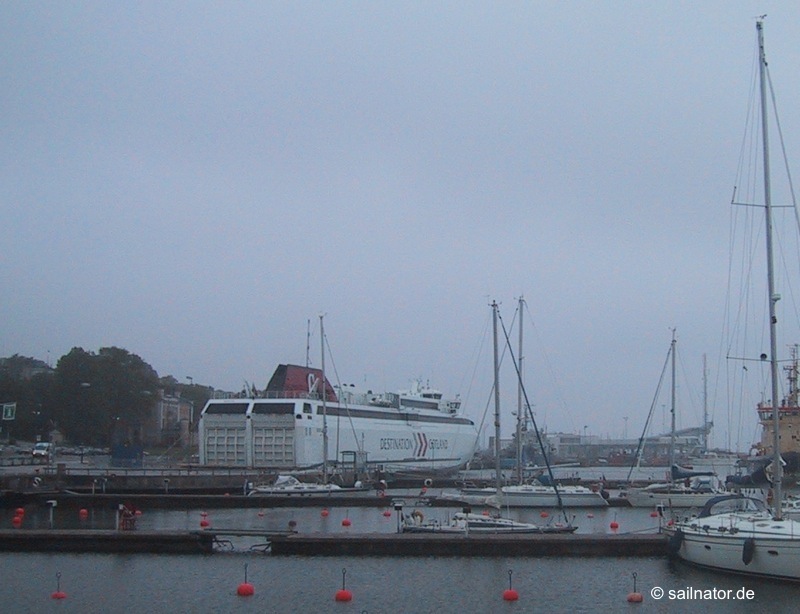
In the late morning we reach Visby. Together with us one of these monster ferries is approaching and tears up the whole water of the harbour with its jet drive. Our skipper organised an old acquaintance that lives on Gotland as a travel guide. Unfortunately the wonderful old town of Visby does not show itself from its best side. It is raining and from the nicest viewpoint we only look into haze. But it is still impressing and I decide to come back anyway.
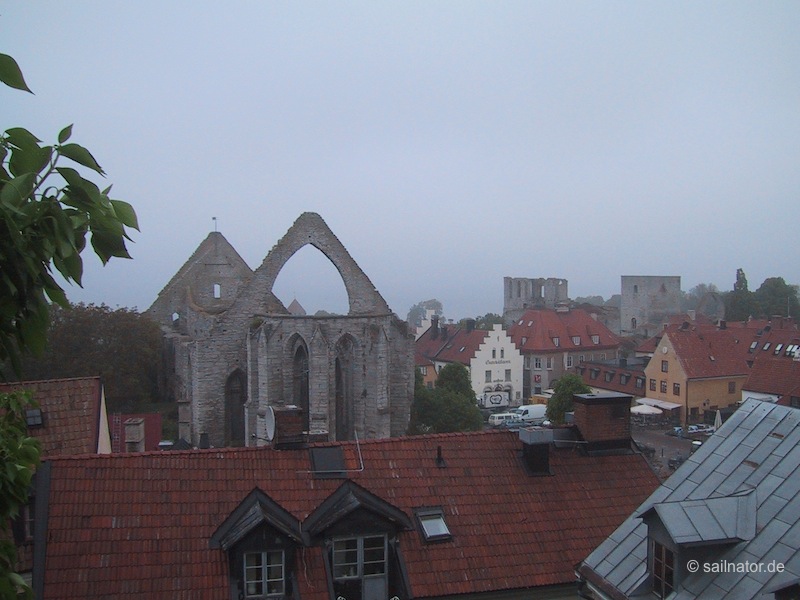
After the guided tour we go to buy some food and leave the harbour in the early afternoon again. Everybody is tired from last night’s ride and wants to rest. That is why a greenhorn like me is allowed to eventually take over as helmsman. We want to reach the Fårösound in the north of the island and dare making the jump across the Baltic Sea tomorrow.
The wind once again blows directly from the direction we want to go to. Beating takes too much time and so we drive by engine again. We head to a cape in the north of Visby and when we get out of its lee a tremendous ground swell hits us. The bow gets up very high and crashes back into the sea. After the second wave we dive through it. A lot water comes in and down through the open companionway. I am totally overwhelmed by the situation. The view from the stern to the wave trough is frightening. The waves are very short and steep. I try to take them more from the side but now there is a danger that the boat broaches. I have to give up with wobbling knees.
A crewmember takes over the wheel and steers the boat into calmer waters. In absolute darkness we reach the Fårösound shortly before midnight. We want to go to a small marina but we do not find it. The entrance is not marked by lights. Only the street lamps burn and they all look the same along the shore. But we go for it. In the meanwhile the wind has increased and makes the manoeuvre very difficult. We catch the wrong entrance. The pilot book is lying on the cockpit table but the wrong page is spread open now. In which harbour are we now? Without a name we cannot find a chart. The helmsman turns around a high concrete pier without thinking about what he is doing. Some fishing boats are tied here and we lay aboard behind them.
We ended in a small port for ferries that go between Gotland and Fårö. There are no showers or toilets. Anyhow nothing is open. The skipper walks to the nearby marina to check the situation. The wind is howling and nobody really has the desire to leave the harbour again and take the risk of an approach in the darkness. As we can now see in the pilot book we luckily did not run aground by rounding the pier. So we are happy that the boat now lies still and safe and we fall in our bunks very exhausted.
Saturday, 2nd June
For the first time on this journey we are awoken by wonderful sunshine. From now on it will leave us only for a few hours at night. It is Midsummer Night soon and the days are getting longer. A nice sailing wind is blowing from NNE and we enjoy the wonderful trip across the Baltic Sea to Latvia. In the Fårösound the sea is still calm but after the second broach we have to reef. We pass the rocky coast of Gotland and Fårö that is grounded smooth by the glaciers of past ice ages. Suddenly the Baltic Sea opens out in front of us. And the Baltic countries are our destination for today. The yacht calmly makes her way through the waves that are decorated with small white crests. Everyone on board is in high spirits. Finally sailing – after driving so many days and nights by engine. It is wonderful! Everybody wants to be the helmsman now to enjoy this experience. Otherwise life on board is relaxed. The skipper even has time to explain the sextant to the crew. At some point the land behind us disappears. But it is important to keep our eyes open now. Again we cross one of the busiest straits of the Baltic Sea. All carriers and ferries that come from or go to Helsinki, St. Petersburg, Riga and Tallinn come along here. I am impressed by the many vessels and their different cargo. We try to guess their country of origin and the port they are going to. Our skipper proves to be the expert in such matters.
Far away on our starboard side a white ferryboat appears. I determine the bearing with the binoculars at 30 degrees. The ferry gets bigger when coming closer. The bearing stays the same. First it seemed that the vessel would take the same course as we did parallel to us. But now the bow is turning slowly in our direction. The bearing is still the same. The vessel is now directly coming towards us. The skipper takes the radio and calls a “Big white ferry at our starboard side”. Somebody answers. “We are the little sailboat on your port side. Do you see us?” asks the skipper. “Yes!” comes back briskly. “Is this O.K. for you?” is our question. “It’s perfect!” is the answer. And a short time later a big white wall crosses in front of us.
From now on there are no special events that affect us anymore. The wind decreases and has more and more an easterly tendency. Unfortunately we cannot keep course directly into the bay of Riga that way. So we take Ventspils in Latvia as waypoint. The skipper plans to take a short rest there and then to continue the trip through the night.
We reach the port at about 10:00 p.m. and only want to berth for a short time to cook and to rest and leave immediately afterwards. With this in mind we drive to some harbour wall to moor up to. Shortly after the lines are tied a rickety old vehicle arrives. The driver tells us that we have to go over to the marina to clear inward. We are not allowed to stay here. Not even for a short while. The prospect on long-drawn-out paperwork of an entry seems not very compelling to us and so we decide to leave the harbour. We drive up the coast by engine for an hour. Then we heave-to and start cooking.
At 10:30 p.m. the sun magnificently sets on the horizon. Even when we sit in the cockpit to have our meal it is far from getting dark. After midnight we continue our trip along the coast northwards.
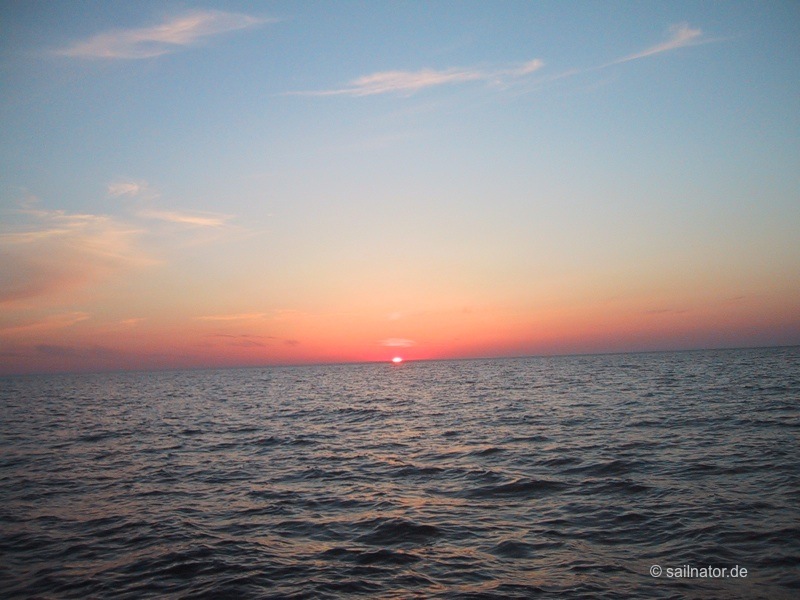
Sunset at 10:14 p.m.
Sunday, 3rd June
Shortly after 05:00 a.m. I sit on deck again. The yacht heels very much. The helmsman tries to beat into the bay of Riga. The sun shines, a wonderful wind blows but we are just not able to get around the cape of Kolka. Our beats go far up, nearly to the Estonian island of Sareema. But on the way down we lose the heights we gained on our way up every time. As if there is a jinx on it. The wind seems to turn into a different direction with each try so that we have to return straightaway to our starting point. But it is fun anyway. Finally sailing!
We always head towards the coast and tack at the 30 feet line to prevent us running aground. Slowly the crew awakes and comes on deck. I could be alternated now but it is much too nice out here to crawl into my bunk. The man who did the watch with me lies down in the cockpit with his head to the stern. Just in the moment he falls asleep a big wave comes over the sprayhood directly into his face.
By about noon we get into the bay of Riga but the wind turns more and more to south east. At some point the skipper decides to go on by engine so that we reach Riga in daylight. The pilot book says that the approach is very demanding. It already dawns when we reach a large roadstead close to the harbour entry. Big vessels anchor in roads here – partly or only dimly lit. Some are still looking for an anchorage and come from all kinds of directions by driving circles around the road. We cannot foresee where they want to go to. But we also do not want to get in the line of the in and out coming vessels. Finally the fairway buoy is reached and the courses of the other vessels can be better made out.
Now it gets dark and everything is even more complicated. Riga is not directly on the coast but about 7 miles upstream the Daugava River. There are docks all the way up there. Their bright lights are seen from far away and they make it difficult to estimate distances. The mouth of the river is protected by a long wall on each side, but it is not possible to enter it straight ahead. The shore is abeam on our starboard side and we try to get the first leading lights in line. But we do not want to get too far into the waterway because of the carriers and ferries that go in and out. As the two lights just begin to line up the helmsman rotates the boat 90° and goes along the outer edge of the leading lights toward the harbour walls. The waterway in front of us is light, but it follows the river and meanders. To us buoys on port side and starboard are partly in line. It seems as if red lights and green lights are both on the left as well as the right side. And there are also the countless entrances of all the smaller harbours. It blinks everywhere and we move zigzag hand over hand along the leading lights that are hard to identify. All the time we are tempted to head a green buoy and leave it on starboard till we recognise that the red one that we are supposed to be behind is actually in front of it and that we nearly got out of the waterway. Suddenly we see a brightly illuminated dock to the left of us that was not there before. Now we realise that a big carrier just passed us that was hiding the banks from our view and we thought his red port side light was a port side buoy.
Finally we reach a part of the waterway that proceeds in a straight line and everything seems to be easier. But suddenly an obstacle appears on our starboard side that is illuminated like a Christmas tree. A digger. Just like in the textbook. But there it is always easy to see on which side the red lights and the green lights are. But not in reality. The object is standing crosswise to us so that the green lights that should show on which side it should be passed are in line with the red ones. We cannot see if they are left or right under the red-white-red lights that characterise the machine as a digger. It just dredges and his work lamps are shining straight in our direction and dazzle us. We drive slowly closer to the gasping monster and try to orientate ourselves. Finely it turns a little bit and we realize what we already guessed: We have to leave it on our starboard side. But now we are already too close to it. Suddenly we hear a vehement stroke that goes through the whole boat. Fear spreads. It seems as if we did not run aground because the yacht drives on. Something banged against the hull. The contingency plan is activated and everybody looks around at the place that he was allocated at the beginning of the trip if there is any incoming water. But luckily there is nothing. But what did we hit? We cannot see anything in our wake line. We find the answer when we leave two days later by daylight.
Monday, 4th June
The skipper sends a crewmember for lookout on the bow. The trip continues slowly. Meanwhile it is long after midnight and we have managed half the distance up the river to Riga. It goes on – past brightly lit docks. Vessels are loaded and unloaded, coal dust is in the air and sometimes it smells unhealthy. Upstream a bridge appears and below a big cruise ship is docked at the pier. We head towards it and recognise just in time the unlit entrance of Riga marina on port side. We turn off the main waterway just to find out that the whole marina is dark. The streetlights are hidden behind big trees and the cruise ship with all its lights lies behind the terminal.
With the aid of a powerful flashlight we berth at the floating jetty and wake the other skippers from their sleep with our manoeuvre. Finally we are moored. The bow of our long yacht extends beyond the finger piers but it is wind-protected here and we are too tired to haul the boat to another berth. It takes some time till the adrenaline has left our veins but then we all fall in a deep sleep.
In the early morning there is a knock on the ship’s side. A customs officer is standing on the finger jetty and wants to see the crew list and our passports. All is prepared and our skipper jumps with the documents in his hand from the deck onto the thin finger jetty. The officer gets catapulted in the air and can save himself before falling into the harbour basin only by grabbing the railing of our boat. Now all crewmembers have to come out of their bunks and have to show their passports individually. And the officer takes his time to do so.
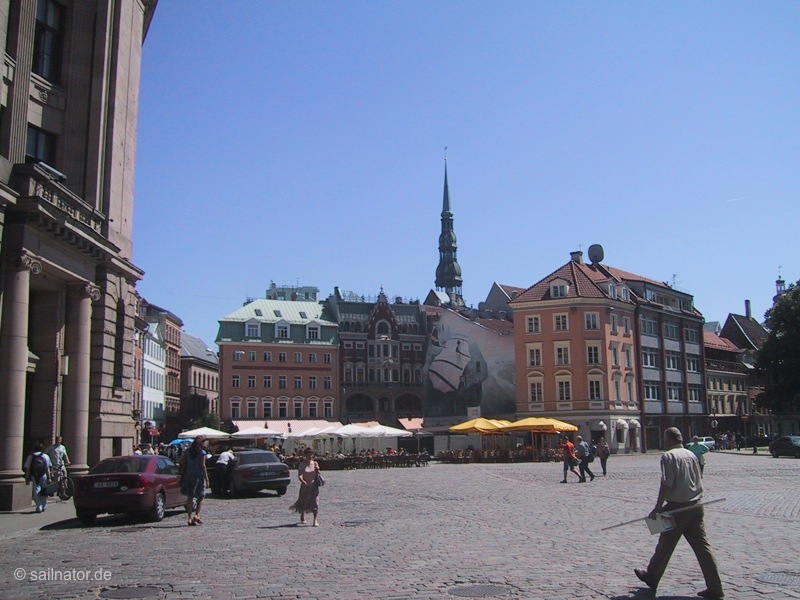
After breakfast the skipper gives us a chance to visit the city. Today is the first real warm day of the year in Riga. The young ladies seem to have organised a competition: “Who can wear the shortest mini skirt?” In addition to that they wear breathtakingly high heels and hover above the medievally cobbled paving as if it were a catwalk. After a week on sea we do not really have a look for the other sights of the city now. We are distracted all the time.
But we still see the marketplace with the town hall and the House of the Blackheads. We visit the Dome Cathedral and the St. Jacob’s church and take a walk through the historic district and along the great examples of the Art Nouveau architecture in the newer part of the town. We see the castle and the Freedom Monument and have a rest in the parks on the former fortifications. All in all it is too much for just one day. I decide to come back sometime. At the end of our tour we buy some groceries and need two taxis to bring us plus the provision back to our boat. In 2007 everything is unbelievable cheap in Riga. A package of cigarettes costs the equivalent of 50 Eurocents. It is hard for us to spend all the Latvian money we got at the cash terminal. Last time that happened to me was in the early eighties in East Berlin with the compulsory changed money of the German Democratic Republic.
After a short rest on board the skipper guides us to a restaurant outside the city in the early evening. We take the tram that costs about 10 Eurocent one way. At the station a local tells us that this is a lot of money for Latvians. The ride to the suburbs shows the social divide of Riga. In the city everything was tidy and fancy and we heard only Latvian. Further outside appear the prefabricated buildings “Made in the GDR”. The new buildings had been a privilege for the Soviet occupiers but now it seems to be a kind of ghetto for the unloved fellow citizens of the new Latvia. They are cut off the developing growth and welfare. Many passengers in the tram seem to be drunk. One man so much that he almost falls out of the train at every stop. Finally we reach our destination. It is a singled-floored building in block house style in a kind of industrial area. Somewhere nearby the River Daugava should be, but it is not visible from here. The garden of the restaurant is packed with people and what they are looking for is not clear on the first sight. Inside we realise what goes on here. There is self-service on different bars and at the exit the price is calculated according to the weight. Many dishes are offered that are characteristic for the country. There is meat in unbelievable quantities and fish and all sorts of vegetables. Just when we decided on something we see something new. One has to come for weeks here to taste it all. We have not been pampered with culinary delights the last week on sea and so we shovel as much as we can onto our plates. At the entrance lurks the cake buffet. We have not had pastries on the whole trip so far. At about 30 Eurocents per piece we go there more often than just once. The Latvians shake their heads about us.
Back on our yacht we enjoy the long evening light and the last keg of beer we bought in Germany. We rave about long legs and discuss the experiences of the last week. We really got to Riga in such short time against all the odds underway.
Tuesday, 5th June
We get up early in the morning today and wait impatiently for the man we sent to clear out. But the custom officers are occupied. They have to dispatch all the passengers of the big cruising ship that leaves today. Only in the late morning we can finally untie the lines.
Now in daylight it is no problem to drive down the river Daugava. We see the chimneys where the black smoke is coming out that we could only smell in the darkness. We pass coal terminals and rundown warehouses. At one point the digger appears on our port side and we recognise what we must have hit the other night. The machine is well anchored. To all directions chains go to the ground. And every anchor is marked by a moored empty jerry can that is floating on the water surface. Unfortunately they are not light. We probably drove over one of them. How fortunate that we did not get stuck in one of those lines.
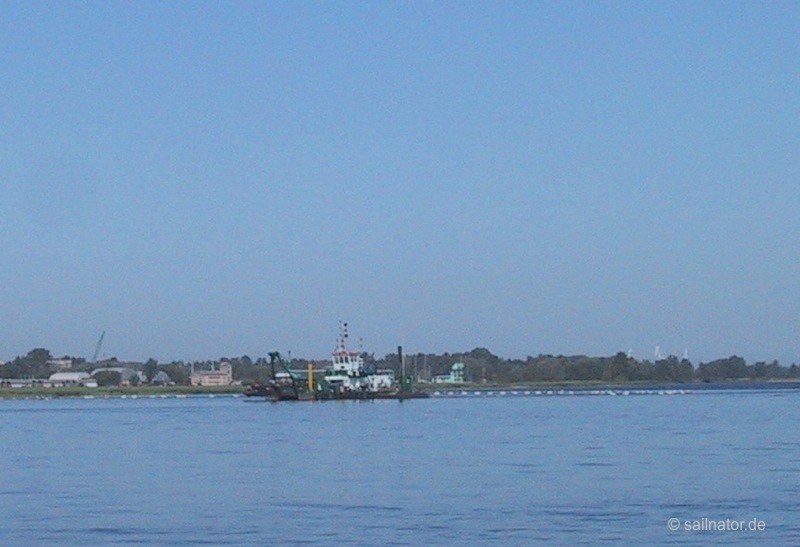
Digger by daylight
Outside in the huge bay of Riga a calm wind is blowing. Strangely enough from the right direction this time for us to sail. The sun is shining and we do not sail fast but we make good progress. A marvellous sailing day! Late at night we sit in the cockpit for dinner while the sun wonderfully goes down in the sea.
Wednesday, 6th June
As I get up for the change of watch the sun has already risen again. For the crew on deck it is not really clear where we exactly are at the moment. The wind decreased and we drive by engine. We are somewhere on the same level as the island of Saarema and head towards the straight between the island of Muhu and the mainland. The island behind the straight seems within one’s reach – as if we would run aground the next moment. This way we cannot keep course. We wake up the skipper. He ascertains that the island is still far away and that the helmsman was tricked by an optical illusion.
But now there are other concerns. Actually we wanted to refuel yesterday before leaving Riga. But after the late clearing out we were in such a hurry that we forgot about it. Actually there is no marina anymore on our way up to Tallinn. We think about going to the port of the small ferry in Virtsu. But we scrap the plan because we do not know if there is a petrol attendant at 6 o’clock in the morning or even a petrol pump. And probably we first have to go to a customs port to clear in.
So we chug through the nice Estonian island world with a slightly queasy feeling. The wind has decreased completely and the sea is absolutely flat. The waterway is narrow and treacherous. Because of that we count the buoys. Mostly there are only green rods that mark the starboard side of the waterway. The next seamark is far away and hard to see in the glistening water. Everywhere stones lie just under the water surface.
The crew and the skipper are on deck to enjoy the sun. Suddenly somebody recognises something flashing far away in our wake line. In the backlight we cannot see what it is.
As it approaches within a 100 yards we identify it as a boat of the Estonian coastguard.
The radar antenna turning on the roof flashes in the sunlight. We slow down. The boat drives abeam of us within shouting distance. The captain holds up his radio and shows that he wants to talk to us. The skipper goes below deck and gets informed that the coastguard has seen us on the radar for quite a while and tried to reach us via radio. While sitting on deck we have not heard them because of the noisy engine. After letting them know of our destination port and what flag we are sailing under the coastguard boat veers around and disappears soon behind us in the glistening light.
Now it is getting hot on board. The only variation of the routine is a seal that puts its head above the water. The fuel gauge continually goes down. In the late afternoon finally Tallinn is in sight. With the last drop of fuel we pass a big roadstead and the Traffic Separation Scheme where the fast ferries from Helsinki run through. With a big wake and bow wave they hurtle towards us. We should not stop here with an empty tank – but everything goes well. We reach the former Olympic marina of 1980 on the other side of the bay. First we go to the petrol station. That is not so easy because the local sailing club just finishes the Wednesday regatta and all yachts enter the harbour and cross our way. The gallons run into the tank for a long time. After the diesel is bunkered it is certain that we were very lucky that we even got here. There probably would not have been enough fuel for berthing in the tank anymore.

Olympic Marina Tallinn
The marina has the charm of the Kiel Schilksee in Germany where the sailing Olympics of 1972 took place. Maybe it was built by the same architect. Unfortunately our sailors could not participate the Olympic Games in Tallinn in 1980. We are glad that this is long ago and that we can now travel to this country easily. We only have to clear in. But before we have to leave our berth because it belongs to a local yacht. When we entered the harbour we missed the guest berths and went just into an empty box. The mooring buoys in the new place are too close to the pier again for our long boat. So we berth alongside. Two yachts that come after us think it has to be like this and imitate us. So the harbour is full now.
After dinner we have a small talk with our neighbours. They tell us about some idiots who had been called by the Coast guard via radio the whole afternoon. But they did not answer. We quickly switch to another topic.
Thursday, 7th June
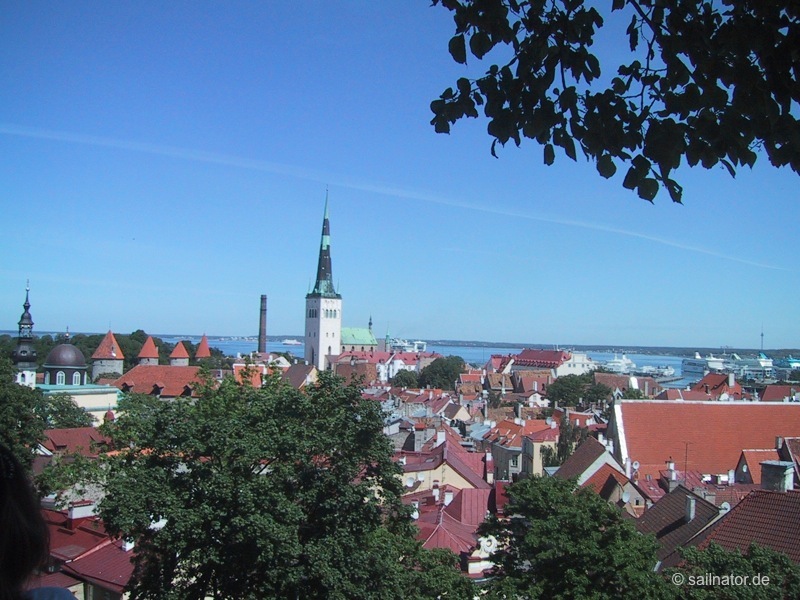
Tallinn
After breakfast we are comfortably carried to the centre of Tallinn by bus. It is already very busy there. Three big cruising ships lie in the harbour and pour out their international passengers. Everybody streams to the historic district that is surrounded by the old city wall. In the centre the gothic town hall from the 13th century is located. The whole square is framed with historic buildings. To escape the turmoil a little bit it draws us to the wonderful alleyways of the old part of the city. All around there are nice little shops and cafes. Most of the storefronts of the buildings are already refurbished and now just the few missing backstreets are renovated. We climb up the hill to the Alexander Newski Cathedral and admire the fantastic view to the city, the harbour or the sea from there above.
Later we sit in our yacht’s cockpit. At about 11:00 p.m. the setting sun turns the sky in unbelievable colours. Tomorrow is the last day of our trip and so we try to enjoy the evening for as long as possible.
Friday, 8th June
We leave the harbour of Tallinn in the early morning. The distance to Helsinki is not very far but even if the wind is calm we want to try to sail as much as possible on our last day. We try to keep out of the way of the fast ferries. They pass us with high speed every half hour. Today is Friday and the Finns come to Estonia to buy cheap alcohol. And they do not only come with big ships. An armada of small powerboats is driving towards us. And suddenly there it is – the entrance to the Helsinki archipelago. First we try to keep on sailing. But it is hard to make out the small harbour ferries suddenly dashing forward from behind the rocks. To dodge is not possible because of the big stones below the surface left and right and the waterway is very narrow. So we secure the sails for the last time. A crewmember goes to the bow for lookout and then we try to find our way through the labyrinth of rocks. We pass old fortifications, huge icebreakers, industrial areas and oil terminals. And finally the city lies in front of us.
The marina is directly in the city centre abeam the main train station. It is situated left and right of a bridge that connects an outlying island with the mainland. We decide to let the island on our port side. But when we arrive the harbourmaster tells us that the guest berths are on the other side. So we have to leave again and have to go across along the outside of the island. About 30 yards away from the banks white rods with a yellow stripe in the middle stand in the water. Nobody of us knows the meaning. The helmsman gets impatient and wants to go through between one of the rods and the last tip of the island. Immediately the depth alarm sounds and we decide to go backwards. On the island a park with lawn for sunbathing is situated. The rods mark the shallow water of the bathing area. That would have been the highlight after so many miles – running aground just 100 yards from our final destination.
We arrive safe and sound. We clear the deck and the crew and drink a well-deserved beer. Afterwards we explore Helsinki. We have dinner on board and sleep the last night on our yacht.
Saturday, 9th June
Shortly after breakfast the first members of the new crew are standing on the pier. It feels strange to give our boat to these strangers. But we abandon the yacht and skipper to their fate and disembark. I want to stay another night in a hotel to visit the city.
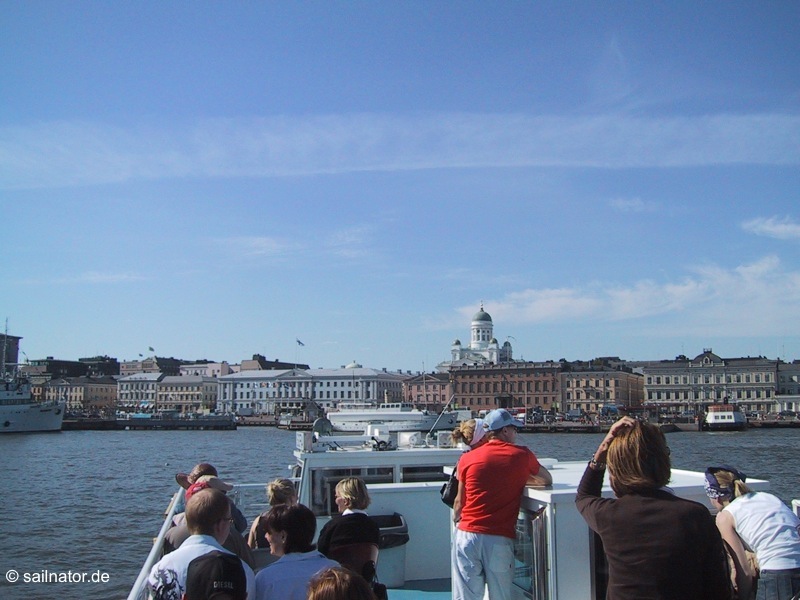
Harbour Boat Tour Helsinki
The summer has now even reached Helsinki. The pale Finns come out of their houses and life proceeds outside. Samba schools from the whole country dance through the streets. Their meeting point is the big plaza below the white cathedral that is visible from far. A big stage is built up there. Which city did we actually sail to? Helsinki or Rio?
I feel a growing dizziness. My sense of balance is swinging from left to right – as if I would be still on the water. But the legs report firm ground under my feet. I am land sick. I try to simulate the sea feeling in the bathtub in my hotel. But it does not help. So I go for a harbour tour on a boat. Immediately I feel very well again.
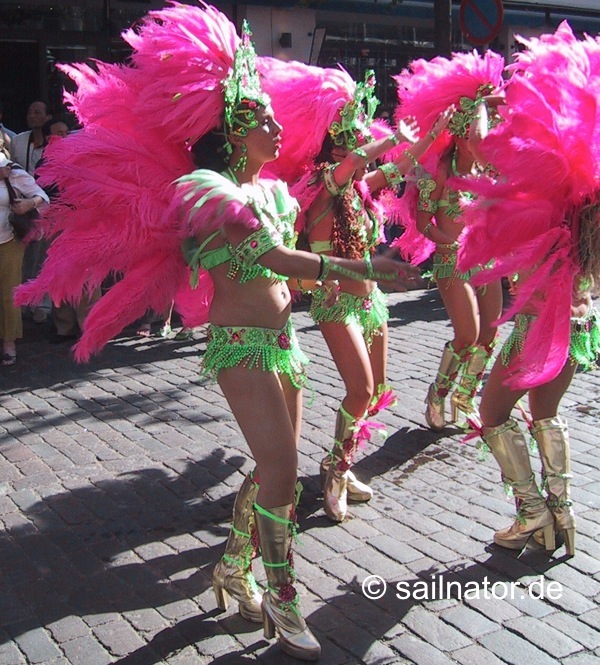
Samba in Helsinki